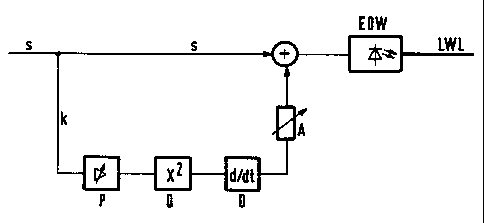Some of the information on this Web page has been provided by external sources. The Government of Canada is not responsible for the accuracy, reliability or currency of the information supplied by external sources. Users wishing to rely upon this information should consult directly with the source of the information. Content provided by external sources is not subject to official languages, privacy and accessibility requirements.
Any discrepancies in the text and image of the Claims and Abstract are due to differing posting times. Text of the Claims and Abstract are posted:
| (12) Patent: | (11) CA 2141560 |
|---|---|
| (54) English Title: | METHOD AND CIRCUIT ARRANGEMENT FOR ELECTRIC COMPENSATION OF SIGNAL DISTORTION CAUSED BY LASER CHIRP AND FIBER DISPERSION |
| (54) French Title: | METHODE ET CIRCUIT POUR CORRIGER LA DISTORSION CAUSEE DANS LES SIGNAUX PAR LES GLISSEMENTS DE FREQUENCE LASER ET LA DISPERSION DANS LES FIBRES |
| Status: | Expired and beyond the Period of Reversal |
| (51) International Patent Classification (IPC): |
|
|---|---|
| (72) Inventors : |
|
| (73) Owners : |
|
| (71) Applicants : |
|
| (74) Agent: | SMART & BIGGAR LP |
| (74) Associate agent: | |
| (45) Issued: | 2004-06-29 |
| (86) PCT Filing Date: | 1993-08-05 |
| (87) Open to Public Inspection: | 1994-02-17 |
| Examination requested: | 2000-06-29 |
| Availability of licence: | N/A |
| Dedicated to the Public: | N/A |
| (25) Language of filing: | English |
| Patent Cooperation Treaty (PCT): | Yes |
|---|---|
| (86) PCT Filing Number: | PCT/EP1993/002092 |
| (87) International Publication Number: | EP1993002092 |
| (85) National Entry: | 1995-02-03 |
| (30) Application Priority Data: | ||||||
|---|---|---|---|---|---|---|
|
For the purpose of electric compensation of
signal distortion in an optical telecommunication system
caused by laser chirp and fiber dispersion, a correction
signal is derived from the electric transmission and/or
reception signal by squaring followed by differentiation
and added to the electric transmission signal and/or
reception signal, respectively, after necessary attenuation.
Note: Claims are shown in the official language in which they were submitted.
Note: Descriptions are shown in the official language in which they were submitted.

2024-08-01:As part of the Next Generation Patents (NGP) transition, the Canadian Patents Database (CPD) now contains a more detailed Event History, which replicates the Event Log of our new back-office solution.
Please note that "Inactive:" events refers to events no longer in use in our new back-office solution.
For a clearer understanding of the status of the application/patent presented on this page, the site Disclaimer , as well as the definitions for Patent , Event History , Maintenance Fee and Payment History should be consulted.
| Description | Date |
|---|---|
| Inactive: IPC expired | 2013-01-01 |
| Time Limit for Reversal Expired | 2006-08-07 |
| Letter Sent | 2005-08-05 |
| Grant by Issuance | 2004-06-29 |
| Inactive: Cover page published | 2004-06-28 |
| Inactive: Final fee received | 2004-04-16 |
| Pre-grant | 2004-04-16 |
| Notice of Allowance is Issued | 2003-11-20 |
| Letter Sent | 2003-11-20 |
| Notice of Allowance is Issued | 2003-11-20 |
| Inactive: Approved for allowance (AFA) | 2003-10-23 |
| Letter Sent | 2003-09-19 |
| Amendment Received - Voluntary Amendment | 2003-08-27 |
| Reinstatement Request Received | 2003-08-27 |
| Reinstatement Requirements Deemed Compliant for All Abandonment Reasons | 2003-08-27 |
| Inactive: Abandoned - No reply to s.30(2) Rules requisition | 2003-07-07 |
| Inactive: S.30(2) Rules - Examiner requisition | 2003-03-05 |
| Letter Sent | 2000-07-13 |
| Inactive: Status info is complete as of Log entry date | 2000-07-13 |
| Inactive: Application prosecuted on TS as of Log entry date | 2000-07-13 |
| All Requirements for Examination Determined Compliant | 2000-06-29 |
| Request for Examination Requirements Determined Compliant | 2000-06-29 |
| National Entry Requirements Determined Compliant | 1995-02-03 |
| National Entry Requirements Determined Compliant | 1995-02-03 |
| National Entry Requirements Determined Compliant | 1995-02-03 |
| Application Published (Open to Public Inspection) | 1994-02-17 |
| Abandonment Date | Reason | Reinstatement Date |
|---|---|---|
| 2003-08-27 |
The last payment was received on 2003-07-21
Note : If the full payment has not been received on or before the date indicated, a further fee may be required which may be one of the following
Patent fees are adjusted on the 1st of January every year. The amounts above are the current amounts if received by December 31 of the current year.
Please refer to the CIPO
Patent Fees
web page to see all current fee amounts.
| Fee Type | Anniversary Year | Due Date | Paid Date |
|---|---|---|---|
| MF (application, 4th anniv.) - standard | 04 | 1997-08-05 | 1997-07-15 |
| MF (application, 5th anniv.) - standard | 05 | 1998-08-05 | 1998-07-23 |
| MF (application, 6th anniv.) - standard | 06 | 1999-08-05 | 1999-07-23 |
| Request for examination - standard | 2000-06-29 | ||
| MF (application, 7th anniv.) - standard | 07 | 2000-08-07 | 2000-07-18 |
| MF (application, 8th anniv.) - standard | 08 | 2001-08-06 | 2001-07-12 |
| MF (application, 9th anniv.) - standard | 09 | 2002-08-05 | 2002-07-22 |
| MF (application, 10th anniv.) - standard | 10 | 2003-08-05 | 2003-07-21 |
| Reinstatement | 2003-08-27 | ||
| Final fee - standard | 2004-04-16 | ||
| MF (patent, 11th anniv.) - standard | 2004-08-05 | 2004-07-13 |
Note: Records showing the ownership history in alphabetical order.
| Current Owners on Record |
|---|
| SIEMENS AKTIENGESELLSCHAFT |
| Past Owners on Record |
|---|
| ERICH GOTTWALD |